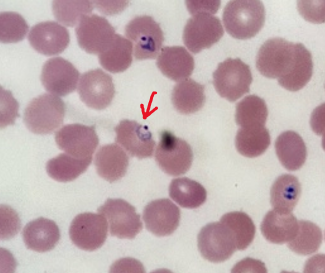Malaria
20%
1 / 5
1. 27 year old pregnant woman (27 weeks gestation) recently traveled to Nigeria and presents to the hospital with 10 days of fevers, fatigue, shortness of breath and chest pain.
Exam: Temperature 100.2 Heart Rate 150s Blood pressure 114/58 Respiratory Rate 36, oxygen saturation 98% room air
General: lethargic, but arousable
Cardiovascular: tachycardic, normal S1 S2
Lungs: crackles at bilateral bases, tachypneic
Abdomen: protuberant, nontender, firm
Extremities: edema, no rash
Labs: AST 49 ALT 45 Total bilirubin 2.4
PLT 56 Hb 8.8 WBC 9.4
blood glucose 37
Malaria smear: P. falciparum 5.3%
CXR shows bilateral infiltrates
Which clinical parameter is NOT used to define severe malaria?
Explanation : Clinical features of severe malaria include: impaired consciousness (including unarousable coma), prostration (i.e. generalized weakness so that the patient is unable to sit, stand or walk without assistance), multiple convulsions (more than 2 episodes within 24 hour period), deep breathing and respiratory distress (acidotic breathing), acute pulmonary edema and ARDS, circulatory collapse or shock, systolic blood pressure < 80 mm Hg in adults, acute kidney injury, clinical jaundice plus evidence of other vital organ dysfunction, and abnormal bleeding.
References:
https://apps.who.int/iris/bitstream/handle/10665/79317/9789241548526_eng.pdf
References:
https://apps.who.int/iris/bitstream/handle/10665/79317/9789241548526_eng.pdf
40%
2 / 5
2. Which laboratory parameter is NOT used to define severe malaria for Plasmodium falciparum?
Explanation : Laboratory findings seen with severe malaria include: hyperparasitemia ≥ 5% in non-immune traveler, all patients with parasitemia > 10%, hypoglycemia (< 40 mg/dl), metabolic acidosis (plasma bicarbonate < 15 mmol/l), severe normocytic anemia (Hemoglobin < 5 g/dL), hemoglobinuria, hyperlactatemia (lactate > 5 mmol/l), renal impairment (serum creatinine > 3 mg/dL or blood urea > 20 mmol/L), and plasma or serum bilirubin 3 mg/dL in conjunction with > 2.5% parasitemia
References :
https://doi.org/10.1111/tmi.12313_2
https://apps.who.int/iris/bitstream/handle/10665/79317/9789241548526_eng.pdf
References :
https://doi.org/10.1111/tmi.12313_2
https://apps.who.int/iris/bitstream/handle/10665/79317/9789241548526_eng.pdf
60%
3 / 5
3. What is the primary regimen recommended for treatment in this patient?
Explanation : Parenteral artesunate is preferred for pregnant women with Plasmodium falciparum malaria.
References :
https://apps.who.int/iris/bitstream/handle/10665/79317/9789241548526_eng.pdf
https://www.cdc.gov/malaria/resources/pdf/Malaria_Managment_Algorithm_202208.pdf
References :
https://apps.who.int/iris/bitstream/handle/10665/79317/9789241548526_eng.pdf
https://www.cdc.gov/malaria/resources/pdf/Malaria_Managment_Algorithm_202208.pdf
80%
4 / 5
4. Below is the patient’s slide. What is the term for when early rings forms appear to be on the peripheral surface of the RBC as opposed to within the RBC?

Explanation : This is a feature of P. Falciparum where the trophozoites may look like they are on the surface of the RBC as opposed to within the cell. This is much more common to see with falciparum than other types of malaria.
References :
https://www.cdc.gov/dpdx/resources/pdf/benchAids/malaria/Pfalciparum_benchaidV2.pdf
Trager W, Rudzinska MA, Bradbury PC. The fine structure of Plasmodium falciparum and its host erythrocytes in natural malarial infections in man. Bull World Health Organ. 1966;35(6):883-5. PMID: 5338378; PMCID: PMC2476278.
References :
https://www.cdc.gov/dpdx/resources/pdf/benchAids/malaria/Pfalciparum_benchaidV2.pdf
Trager W, Rudzinska MA, Bradbury PC. The fine structure of Plasmodium falciparum and its host erythrocytes in natural malarial infections in man. Bull World Health Organ. 1966;35(6):883-5. PMID: 5338378; PMCID: PMC2476278.
100%
5 / 5
5. Hypoglycemia is an important manifestation of falciparum malaria and is associated with an increased risk for mortality. Which of the following is a possible sign and symptom of hypoglycemia in a patient with malaria?
Explanation : In conscious patients, patients may present with anxiety, diaphoresis, dilated pupils, shortness of breath, cold sweats, tachycardia and light headedness. If symptoms are protracted and severe, the patient may lose consciousness and develop generalized seizures and extensor posturing. Because all of these clinical features can be present in severe malaria, hypoglycemia can be easily overlooked. If hypoglycemia is present, WHO recommends giving 25 g of dextrose (preferably 10% dextrose) over a few minutes. This should be followed by intravenous infusion with D5% or D10% at 200-500 mg/kg per hour with ongoing blood glucose monitoring.
References :
https://apps.who.int/iris/bitstream/handle/10665/79317/9789241548526_eng.pdf
References :
https://apps.who.int/iris/bitstream/handle/10665/79317/9789241548526_eng.pdf
Thank you for completing the questions!
There were a total of {{total_questions}} questions of which you answered {{correct_count}} question(s) correctly and {{wrong_count}} question(s) incorrectly.

